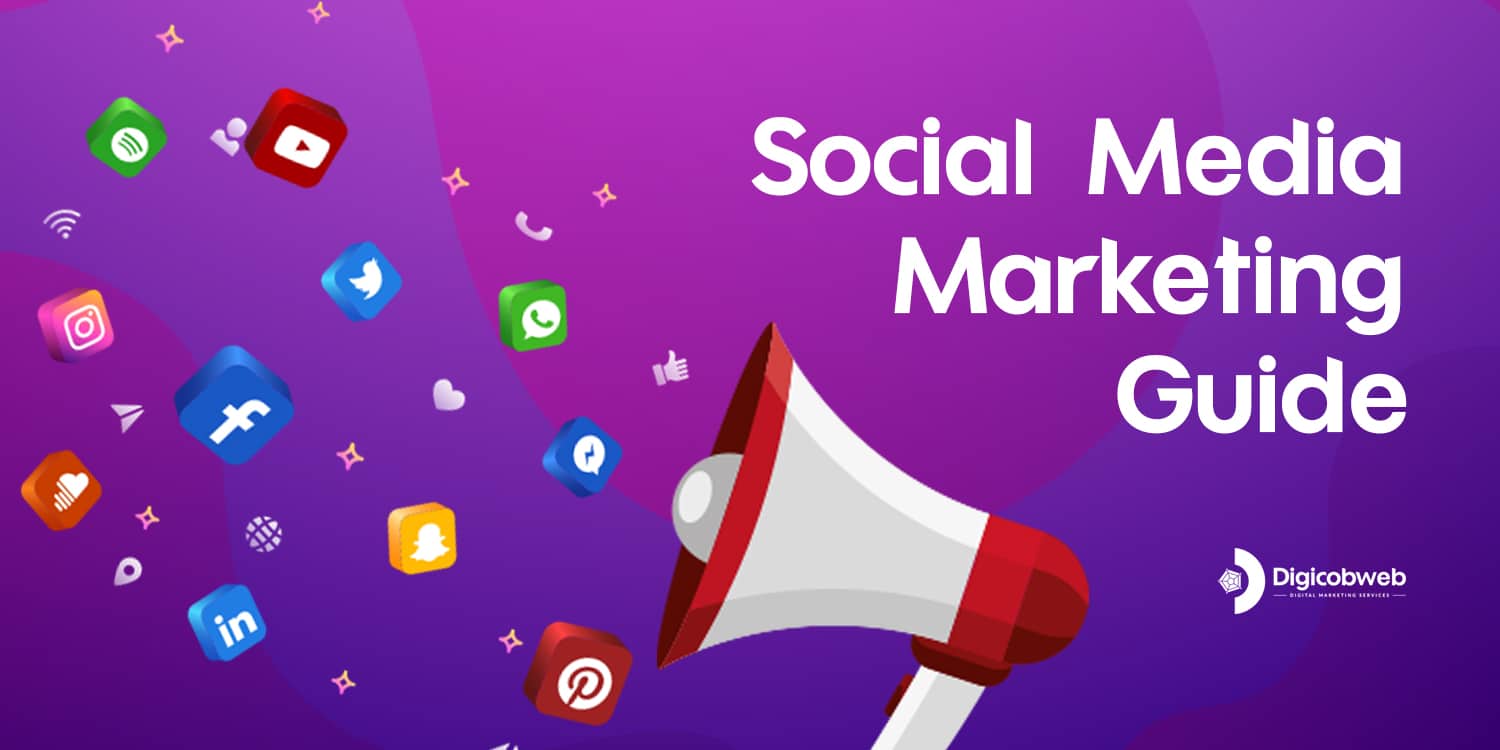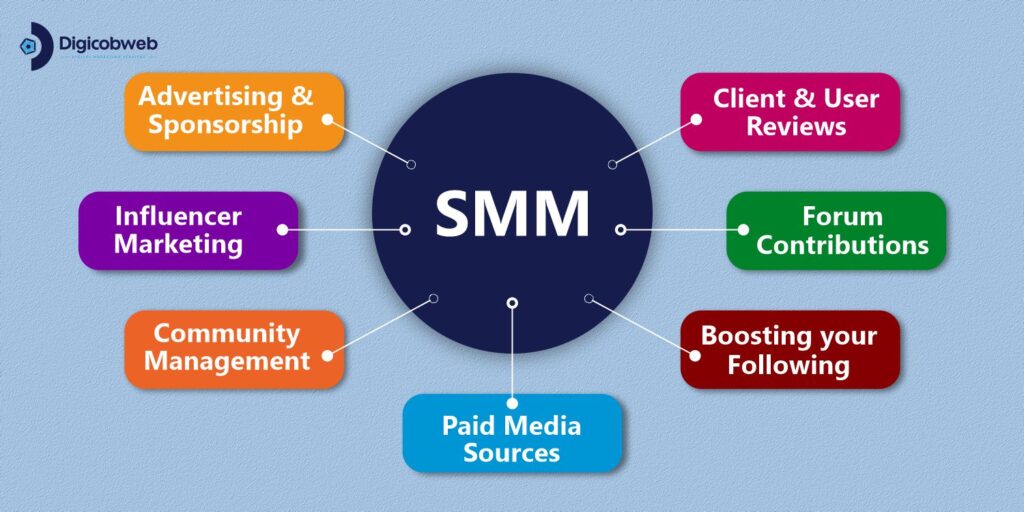
In my comprehensive beginner’s guide to social media marketing, you will learn what is a social media marketing strategy, the history of social media advertising, and how to create a social media campaign strategy.
I will explain the growing importance of digital and social media marketing along with examples of social media marketing tactics.
Furthermore, my “Social Media Marketing Guide for Beginners” will assist you in exploring how marketing strategy varies according to different platforms and what remains the same. I will also highlight how to create a social media marketing plan, what goes into crafting the best social media marketing strategy, and enable different social media marketing activities.
What is Social Media Marketing?
Social media marketing is the procedure of crafting content for social media platforms to market your products and services, create a community comprising your audiences, and steer traffic to your company. With innovative features and new platforms coming up each day, social media marketing is continuously advancing.
Social media marketing is all about assembling with your prospects and clients where they are and as they socially engage with each other and your business brand.
While social media marketing as a whole is extremely valued and advantageous to your business growth, your strategy and tactics will diverge based on which social networks your audience invests their most time on.
History of Social Media Marketing
Andrew Weinreich created Six Degrees, the first official social media site, in 1997. The platform enabled the user base to upload a profile and be friends with other followers, facilitating the chance for social networking.
Thefacebook platform was launched by a Harvard student in 2004. It later changed its name to Facebook, the giant we know today.
In 2006 the social media site enlarged its network, allowing membership from outside universities. By October of the same year, Facebook had millions of user base. A month later, Facebook Ads were successfully launched.
YouTube was introduced by former PayPal employees in Feb 2005. Google bought the portal in 2006, since which it has run as one of Google’s holdings.
New platforms emerged around the same time, such as Twitter (launched in 2006) and Instagram (established in 2010). As soon as online marketers saw the swift growth figures, they rushed to these new platforms.
LinkedIn (introduced in 2002) stands out because of its exclusive business-to-business positioning and unique focus on business networking and career advancement. With 810 million users globally, LinkedIn stays a favorite for B2B marketers.
Importance of Social Media Marketing for Businesses, Creators and Individuals
By leveraging social media, B2B leaders, creators, and individuals benefit by reaching and narrowing their target audiences based on diverse criteria such as age, gender, place, interests, user base behaviors, professional titles, and aimed industries.
1. Create Brand Awareness
Across diverse social platforms, organizations can tell their story, why they offer the services they currently deliver, and preserve audiences with the latest trends, client and employee stories.
If B2B leaders can use the voice of their stakeholders and employees, they can outspread their brand reach even more. Each employee has an individual network, and every network has possibly thousands of contacts. Also, each of those contacts is linked to thousands of other people.
2. Generate Leads
You can create expressive conversations within your target industries by promoting videos, news, insights, and thought-provoking trends on social media sites. Not only do you build integrity with your clients, but these social media tactics can result in gaining leads.
3. Nurture Leads
Social selling empowers sales staff to build and shape relationships with leads. By using thought leadership content, social proofing, and other conversant content, they can assist potential clients in resolving challenges. In turn, this enables your sales team to create confidence and authority.
4. Enable Social Listening
Listen to clients and what people are saying about your organization. This gives you an opportunity to get open feedback about how others view your business and brand. It opens a window into refining the weaker parts of your business while strengthening facets that already exist with people.
5. Link Social Posts to Business Openings
With the precise enterprise solution, social media marketing leaders can steer social posts to the CRM to comprehend clients better.
6. Measure Efforts
Social media management tools allow you to monitor key performance metrics (KPIs). You can even allocate a fiscal value to organic social media interactions. Earned media value (EMV) provides details of your organic social engagement and reach that would have cost if you had leveraged ads.
7. Steer Thought Leadership
Being on social media platforms offers business brands a chance to steer thought leadership by resolving issues and challenges. Craft how-to guides, webinars, and other useful content to assist people and, in reply, people could better trust your brand for business guidance.
8. Build and Shape a Community
With proper planning, you can create an active community around your business on social media. You can use employees and clients alike to produce instant Likes and Shares for your promoted content so that it reaches fresh audiences.
9. Build User-generated Content
User-generated content (UGC) can speak to brands in more dependable approaches, and they keep your content publishing channels full of fresh content.
10. Connect with Key People
Distributing thought leadership posts through social media is a preferred methodology for meriting the consideration of topmost stakeholders. Use webinars, eBooks, videos, podcasts, and other content to resolve the challenges of people in your social networks.
What are the Categories of Social Media Marketing?

Sideways from the likes of Facebook, LinkedIn, Twitter, and Instagram promotions, social media marketing takes many diverse categories and approaches, such as:
o Advertising and Sponsorship
o Influencer Marketing
o Community Management
o Paid Media Sources
o Boosting your Following
o Forum Contributions
o Client and User Reviews
How to Create and Shape a Social Media Marketing Strategy
Step 1: Research your target audiences
Step 2: Decide on which platforms you will promote on
Step 3: Determine significant metrics and KPIs
Step 4: Explore your competition.
Step 5: Craft unique and appealing content.
Step 6: Set a schedule for your posts.
Although social media is repetitively developing, most of the opening steps you require to succeed remain similar. Principally, you are creating a digital marketing strategy and narrowing it to a precise channel.
Let’s cover these steps in more aspects so you can start using and applying them to your business.
Step 1: Research your target audiences.
The foremost step to crafting a social media marketing strategy is to comprehend who your buyer personas and audience are so you can target their requirements fittingly.
To do this, think about the people you are attempting to reach and why and how you would categorize them as a group. For instance, if your company sells trendy headphones, you might categorize one of your target audiences as millennials who like to use stylish accessories.
By comprehending your buyer personas and targeted audiences, you will then be able to decide what content will appeal to them and create engagements to keep them interested.
Step 2: Decide on which precise platforms you will market on
You must focus on those social channels where your target audiences tend to spend most of their time.
For instance, if you are going for that target audience of leisure-loving millennials, you may want to concentrate on Instagram, as millennials cover the biggest portion of the user base on the Instagram platform.
Step 3: Determine substantial metrics and KPIs
No matter your business objectives or industry, your social media strategy should be data-steered.
The important social media metrics include:
o Reachability analytics of your feeds
o Clicks on content or account
o Analysis of impressions and interactions
o Breakdown of hashtag performance
o Comparison of organic and paid likes
o Sentiment Analysis of the brand.
Step 4: Explore your competition.
A competitive analysis enables you to comprehend who the competition is and what they are doing good and not so well. You will get a better sense of what’s anticipated in your sector, which will assist you in setting precise social media targets of your own.
For instance, if your competitor is leading on Facebook but has placed lesser efforts into Twitter or LinkedIn. You might want to concentrate on the networks where your audience is less catered rather than attempting to win fans away from a leading player.
Step 5: Create unique and pleasing content.
With billions of social media user bases across the world, there is no question that at least some of your followers have browsed your competitor’s content.
That is why you must have appealing and unique social media content that offers viewers a reason to follow you and your brand.
For instance, you can take live videos and promote them on Facebook by sharing the details about your product launch or comprehending a giveaway.
You can also use your client and partners to assist you in generating content. You can do this by re-promoting their content or inspiring them to leverage a hashtag to share their experiences with your products.
Step 6: Set a schedule for your posts.
One of the calmest approaches is to ensure your content is shared timely and as planned. Social media tools enable you to write captions, create pictures and videos, and schedule posts right in advance.
How Marketing strategy varies according to different platforms & What remains same

a. Facebook
Facebook is the biggest social media platform. Since its launch, it has turned into a precious tool for B2C businesses, providing modern advertising tools and organic opportunities.
A smart Facebook marketing strategy and an explicit Facebook advertising strategy are most used tactics for connecting with your target audiences. By leveraging social media marketing for Facebook can effectively boost your digital traffic.
b. Instagram
When it comes to sharing visually persuasive content, Instagram is where people go. Another thing that sets the platform apart is its progressive eCommerce tools.
These days, users can explore brands, go through their products and complete a buying without ever leaving the application, making Instagram a highly competitive platform to beat.
Instagram marketing and advertising strategy comprise organic content, paid content, story ads, shopping advertisements, influencer marketing and much more.
c. Twitter
Using twitter for marketing lets you share content swiftly and helps initiate conversations with your audiences.
Twitter marketing and content strategy places its most focus on words. The platform comprises an audio tool known as Twitter Spaces, a community-creation tool known as Twitter Communities, and Twitter Moments to share fascinating content with followers.
One of the best twitter marketing examples includes the search engine company DuckDuckGo, which has made much success with its marketing tweets. Instead of only marketing to present followers, they have reached similar but new audiences through Twitter.
d. YouTube
As per HootSuite, YouTube is the second most visited portal globally. It is the best platform for building strong communities.
It features long-form content, making it a precise platform for sharing informative and educational video content.
Social Media Campaign Examples of Big Brands with Statistics
Here are some social marketing campaigns examples of Big Brands with statistics and why they succeeded:
1) IHOP “alters its name” to IHOb
IHOP, an International House of Pancakes, changed the “P” in IHOP into a “b” to craft IHOb. It was a PR stunt; however, it did create so much buzz that social media went insane.
The social media campaign generated 28,000+ media stories, earned-media valuation of $113+ million and got 42.5+ billion impressions.
2) A Procter & Gamble Commercial
A Procter & Gamble social media commercial that promotes social distancing across the Covid-19 crisis was viewed around 17 billion times in the last three months, thanks to swift work by the P&G team and the smooth dance steps of Charli D’Amelio, a 16-year-old social media influencer.
3) Detox Your Feed Campaign
Dove introduced its latest campaign, #DetoxYourFeed, to display the harm created by toxic beauty instructions on social media. The campaign found that one in two girls had low self-esteem as an outcome of perfect beauty content on social media.
A further seven in 10 girls felt good after they unfollowed such content. This research was executed through 1,500+ respondents, including girls amid the ages of 10 and 17, and grabbed immense attention, helping teens as well as parents.
How to Create your Social Media Marketing Plan
Initiating on the ground floor and building up, here is our outline of how to produce a social media marketing plan from scratch.
Step 1: Select your social networks
Choosing social networks depend on the targeted audience, time, and accessible resources.
o Audience: Where do your probable clients hang out? Which social network has the precise demographics?
o Time: How much time can you dedicate to a social network? Once you get going, automated tools like Buffer can assist you to save your time.
o Resources: What skill sets and professionals do you have to work with? Facebook stresses higher quality content. Pinterest and Instagram need images and videos. Do you have the resources to craft what’s required?
Step 2: Fill out your profiles entirely
Profiles will need two integral parts
1) Visuals
2) Text
For visuals, you must aim for constancy and acquaintance with the visuals leveraged on social media. Your profile photo should match on Instagram and Facebook. Your cover picture on Twitter must be similar to that on LinkedIn.
For text, your main area to adapt is the bio and info section. A professional social media bio must be informational and friendly.
Step 3: Identify your voice and tone
Work on questions like these:
o If your brand was an individual, what sort of personality would it have?
o If your brand was an individual, what’s their association with the customer?
o Are there any organizations that have a similar personality to your brand?
o How do you want your clients to think about your organization?
Step 4: Pick your posting strategy
Find responses to what is the precise number of posts per day. How frequently should you post? At what time should you post? What content should you post?
Step 5: Analyze and test
The more you post, the more you’ll learn which content, timing, and rate of recurrence are precise for you.
Step 6: Automate and engage
You must have a proper system you can follow to assist you in remaining on top of the latest updates and interacting with your community. To initiate with, automate your social media postings.
Social Media Marketing Tips
So here are tips to up your social media game and effectively market your brand.
1. Craft a Robust Strategy
Every platform requires its strategy. Each platform is diverse in some approach, and it is vital to comprehend what works best to generate targeted content and engagements.
Some questions to anticipate are:
o Why am I leveraging this social media platform?
o Who are my targeted prospects or customers?
o What business message am I trying to communicate?
o What content fits best on this particular platform?
o How can I make my content exceptional and helpful?
2. Be Steady
Irrespective of your business size and what platform you are leveraging, be mindful of keeping these facets steady and consistent:
o Brand Image
o Business Message
o Posting Regularity
o Use of Hashtags
3. Create and Shape Engagements
Engaging with your followers is significant in building a community and feeling more friendly. Conducts to do this comprise:
o Liking and responding to user comments
o Enable live streaming
o Crafting polls and quizzes
o Post content that attracts
o Monitor and analyze key metrics
Best Social Media Marketing Tools
o Buffer
It was initiated as a scheduling tool for Twitter. Today, it backs all the main social media platforms, together with Facebook, Instagram, Pinterest, and LinkedIn.
o Buzzsumo
It helps in researching your competitors and to better comprehend what they are doing and if what you are doing is really working or not. It also tells you how your content is performing and who is distributing the word.
o MeetEdgar
So, you require a content manager as you are fully occupied with content creation, technology support, and design tasks. Try MeetEdgar.
o Hootsuite
In the confused space of social media, Hootsuite manages numerous social media accounts, bringing them under one login into a solitary dashboard, and you can sign up without any charges.
o Mention
Mention is an enormously inclusive social listening tool. It tracks mentions of your brand, your services, or your competitors on a real-time basis.
o Sumo
Sumo has a complete suite of traffic monitoring features and is used as a social media tool that can support and enhance your digital marketing strategy.
o Bitly
It is a link shortener tool, shrinking lengthy URLs into smaller ones for ease of use and tracking.
o Postoplan
Postoplan is used to craft content plans and scheduling of posts if you operate multiple social media accounts. It also helps in generating fresh social media post motivation every day.
Best Social Media Resources
Taking a social media marketing course will assist you in level-up your current skill sets or kickstarting a career in digital marketing management.
Here are 10 finest Social Media Marketing Courses to take online:
1. Social Media Certification Course by HubSpot
2. Fundamentals of Digital Marketing by Google
3. Social Media Marketing Masterclass by Mark Timberlake and Philomena Timberlake
4. Social Media Specialization by North-western University
5. Online Advertising & Social Media by the Maryland University
6. Social Media Marketing Course by Acadium
7. Digital Marketing 101 by the Institute of Boot Camp
8. Social Media Marketing Foundations by Brian Honigman
9. Fundamentals of Digital Marketing, Social Media, and E-Commerce by The Wharton School
10. The Strategy of Content Marketing by University of California, Davis
Moving Forward: Initiate Marketing on Social Media Platforms
Comprehending the fact that there are billions of people and professionals on social media today, it’s straightforward to see why so many businesses and digital marketers leverage these channels to market their products and interact with clients.
While defining your company’s social media course of action may seem multifaceted, you can evade feeling stunned by exploring social media marketing trends and leveraging some of the many resources accessible about the topic. So, initiate working on your company’s social media marketing strategy to boost your followers, enhance engagement, and increase conversions.Also, if you need our assistance as a digital marketing service provider company, we at Digicobweb can make a significant social media presence for your company.



